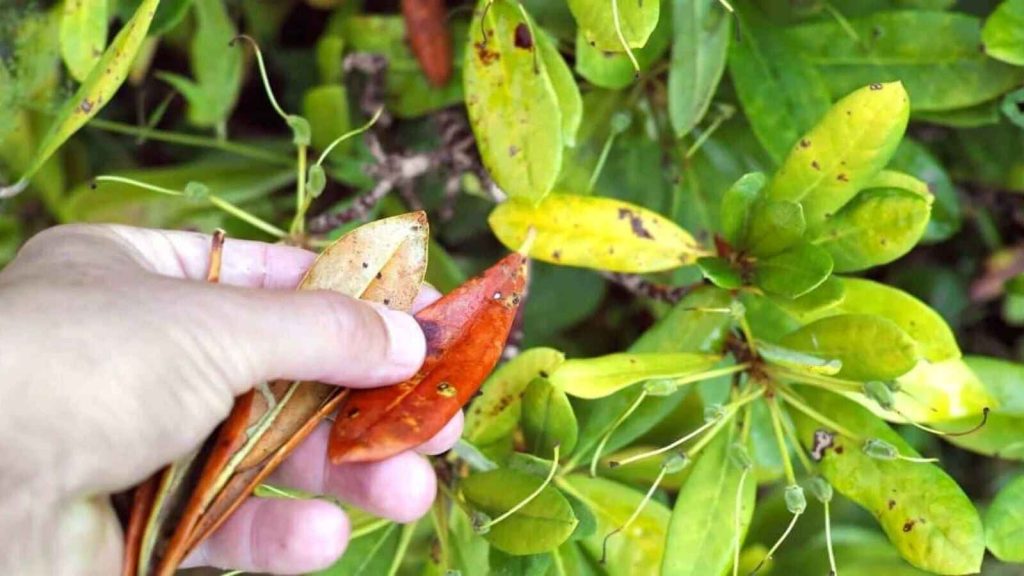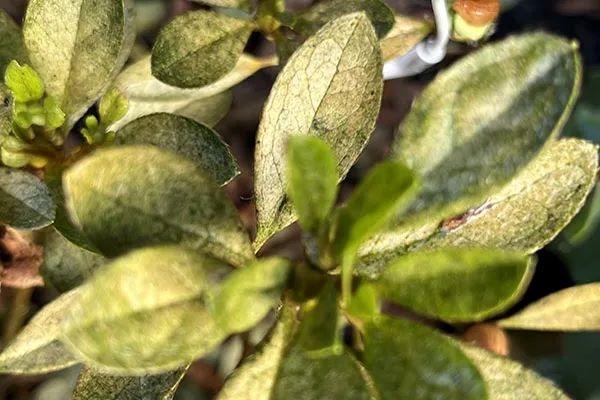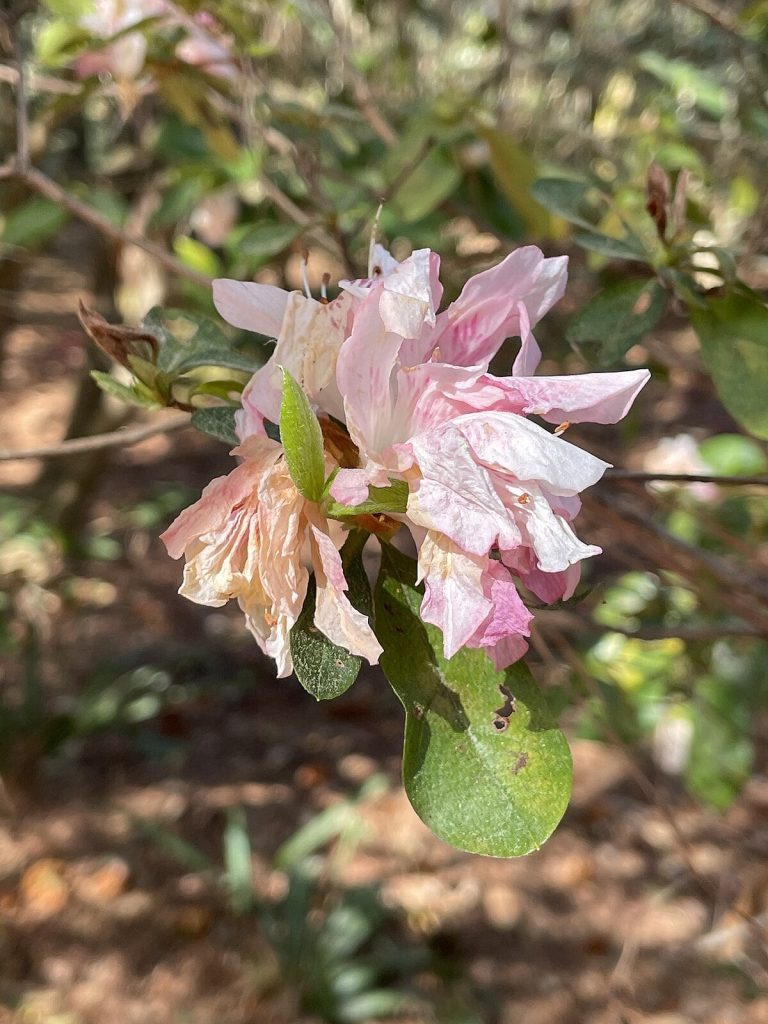Your cart is currently empty!

Introduction: Understanding Azalea Care
Azalea care tips are important to keep these beautiful plants healthy and full of colorful flowers. Azaleas are loved for their bright blooms and deep green leaves, making them a favorite in gardens and pots. However, they need the right care to grow well. If they don’t get proper attention, they may develop problems like yellow leaves, wilting flowers, or slow growth. Pests and diseases can also make them weak and unhealthy.
If you notice your azaleas struggling, don’t worry! Most problems can be fixed with simple steps. This guide will explain common azalea issues and how to solve them. By learning how to water, feed, and protect your azaleas correctly, you can keep them strong and beautiful. With the right care, your azaleas will bloom year after year, bringing color and life to your garden!

1. Why Are My Azalea Leaves Turning Yellow? (Azalea care and Troubleshooting)
Yellow leaves on azaleas can be a worrying sight, but don’t panic! This usually means your plant needs a little extra care. The good news is that most problems can be fixed with the right Azalea care tips.
Azalea leaves can turn yellow for many reasons. It might be getting too much water, not enough nutrients, or too much sunlight. Sometimes, pests or diseases can cause trouble. But with a few simple Azalea care tips, you can help your plant get back to looking green and healthy.
The first step is figuring out what’s wrong. Once you know the cause, small changes—like adjusting watering, adding the right food, or moving the plant to a better spot—can make a big difference. Keep reading to learn the best Azalea care tips to bring your plant back to life!
Lack of Nutrients
Azaleas need certain nutrients to stay healthy and keep their leaves green. When the soil doesn’t have enough of these nutrients, the leaves can start turning yellow. The two most common nutrient problems for azaleas are:
- Not Enough Nitrogen
- Nitrogen helps plants grow and keeps their leaves green. If azaleas don’t get enough nitrogen, the older leaves (the ones at the bottom) turn yellow first. The plant may also look weak and grow more slowly.
- Iron Deficiency
- Iron is important for healthy leaf color. If an azalea lacks iron, the leaves may turn yellow while the veins stay green. This usually happens in younger leaves first. It often means the soil is too alkaline, making it hard for the plant to absorb iron.
How to Fix It
Check the plant’s roots—if they’re compacted or unhealthy, they may not be absorbing nutrients properly. Loosening the soil can help.
Use a fertilizer made for azaleas or acid-loving plants. These fertilizers have the right nutrients to keep leaves green.
If you think the soil is too alkaline, add organic matter like compost or pine needles to make it more acidic.
Too Much Water or Poor Drainage
Azaleas need the right amount of water to stay healthy. While they like moist soil, too much water can be a big problem. If the roots sit in water for too long, they can start to rot. When this happens, the plant can’t take in the nutrients it needs, and the leaves may turn yellow.
Signs of Over-watering or Poor Drainage:
- Leaves turn yellow and feel soft or mushy.
- The plant looks weak or starts wilting even when the soil is wet.
- The soil stays soggy for a long time and has a bad smell.
- Roots may look dark and mushy instead of white and firm.
How to Fix It:
Avoid heavy clay soil – Clay holds too much water. If your azalea is planted in clay soil, mix in organic matter like pine bark or peat moss to help with drainage.
Check the soil – Stick your finger in the soil about an inch deep. If it still feels wet, wait before watering again.
Improve drainage – If your azalea is in a pot, make sure it has drainage holes. For plants in the ground, mix in sand or compost to help water drain better.
Water properly – Only water when the top layer of soil feels dry. In hot weather, water in the morning so the soil has time to dry out during the day.
Too Much Sunlight
Azaleas grow best in places with partial shade. If they get too much direct sunlight, especially during the hottest part of the day, their leaves can start turning yellow. Too much sun can dry out the soil quickly, making it hard for the plant to absorb water and nutrients. This can lead to stress, causing the leaves to fade, turn yellow, or even get brown spots.
Signs of Too Much Sun:
- Leaves turn yellow, especially on the side facing the sun.
- Some leaves may have brown, crispy edges or spots.
- The soil dries out too fast, and the plant looks wilted.
- Flowers fade quickly or don’t last long.
How to Fix It:
Water regularly – In hot weather, check the soil often and water when the top feels dry.
Move the plant – If your azalea is in a pot, place it in a spot with morning sun and afternoon shade.
Provide shade – For garden azaleas, plant them near taller trees or buildings that give shade during the hottest part of the day.
Mulch the soil – Add a layer of mulch (like pine bark or leaves) around the base to keep the soil moist and cool.
2. Common Azalea Pests and How to Get Rid of Them
Azaleas are beautiful and full of color, but sometimes tiny bugs can cause big problems. These pests suck the plant’s nutrients, damage the leaves, and make the azalea weak. If they’re not controlled, the leaves may turn yellow, curl, or even fall off. But don’t worry! With the right azalea care tips, you can protect your plants and keep them healthy.
Some pests, like lace bugs and spider mites, are so small you might not even notice them. Others, like caterpillars, chew big holes in the leaves. If you see sticky spots, tiny black dots, or webbing on your azaleas, pests might be the problem. The good news? Most pest problems can be fixed with simple azalea care tips like spraying the leaves with water, introducing helpful insects, or using insecticidal soap.
By checking your plants often and acting fast, you can stop pests before they take over. Follow these azalea care tips, and your plants will stay strong, green, and blooming beautifully!

Lace Bugs
Lace bugs are one of the most common pests that attack azaleas. These tiny insects live on the underside of the leaves and feed by sucking the plant’s juices. Over time, this damages the leaves and makes them look unhealthy.
How to Spot Lace Bugs:
- Leaves start getting small yellow or white spots, especially on the top side.
- If you flip the leaf over, you’ll see tiny black specks—this is lace bug waste.
- In serious cases, leaves may turn brown and dry out.
- If left untreated, the plant can become weak and stop growing well.
How to Get Rid of Them:
- Spray with water: A strong blast of water from a hose can knock lace bugs off the plant.
- Use insecticidal soap or neem oil: Spray the undersides of the leaves where the bugs hide. Repeat every few days until they are gone.
- Encourage natural predators: Ladybugs and lacewing insects eat lace bugs, so having them in your garden can help.
- Avoid over-fertilizing: Too much nitrogen can make plants more attractive to lace bugs.
Regularly checking your azaleas for lace bugs can help you catch them early before they do too much damage. Keeping your plants strong and healthy also makes them less likely to be attacked!
Spider Mites
Spider mites are tiny pests that can cause a lot of damage to azaleas without being noticed right away. They are so small that they look like tiny dots on the leaves, but their damage can be serious if not treated in time. These pests suck the juices from the leaves, making the plant weak and unhealthy.
How to Spot Spider Mites:
- Leaves start looking speckled with tiny yellow or brown spots.
- A fine, silky web may appear on the leaves and stems.
- If the problem gets worse, leaves may dry out, curl, or even fall off.
- You may notice the plant looking dull or losing its healthy green color.
How to Get Rid of Spider Mites:
- Spray with water: A strong spray of water can wash off spider mites and their webs. Do this in the morning so the leaves have time to dry.
- Use insecticidal soap or neem oil: Spray the leaves, especially the undersides, where mites like to hide. Repeat every few days if needed.
- Increase humidity: Spider mites love dry conditions. Misting the plant or placing a small dish of water nearby can help keep them away.
- Introduce natural predators: Ladybugs and predatory mites eat spider mites and help control their numbers.
- Prune heavily infested leaves: If some leaves are badly damaged, trim them off to stop the mites from spreading.
Checking your azaleas regularly and keeping them well-watered can help prevent spider mites from becoming a big problem. Healthy plants are always better at fighting off pests!
Azalea Caterpillars
Azalea caterpillars are one of the most destructive pests that can attack azaleas. These caterpillars feed on the leaves, often in large groups, and can quickly strip a plant bare if not controlled in time.
How to Spot Azalea Caterpillars:
- Leaves have large holes or are completely eaten.
- Some leaves may be curled or chewed around the edges.
- You might see clusters of caterpillars on the underside of leaves or along the stems.
- Young caterpillars are small and reddish, while older ones turn black with yellow stripes and a red head.
How to Get Rid of Them:
- Handpick them: If you only see a few caterpillars, pick them off by hand and drop them in a bucket of soapy water.
- Prune affected leaves: If certain branches have a lot of caterpillars or eggs, trim them off to stop the spread.
- Use Bacillus thuringiensis (Bt): This is a natural bacteria that targets caterpillars but is safe for other beneficial insects. Spray it on the leaves where caterpillars are feeding.
- Apply insecticidal soap or neem oil: These natural treatments can help reduce caterpillar populations without harming the plant.
- Encourage natural predators: Birds, wasps, and certain beetles feed on caterpillars, so having a balanced garden ecosystem can help keep them under control.
Since azalea caterpillars can eat through leaves quickly, it’s important to act fast as soon as you see them. Regularly checking your plants and removing caterpillars early can save your azaleas from serious damage.
3. Common Azalea Diseases and How to Treat Them
Azaleas are beautiful plants, but they can sometimes get sick due to fungal or bacterial infections. These diseases can cause problems like yellowing leaves, brown spots, root rot, and even flowers that wilt too soon. If not treated, the disease can spread to other parts of the plant or even to nearby plants.
Many diseases in azaleas happen due to too much moisture, poor airflow, or unhealthy soil. Fungal infections and bacterial issues can spread quickly, making the plant look unhealthy. Following the right azalea care tips can help prevent these problems and keep your plant strong.
By understanding common plant issues and applying the best azalea care tips, you can enjoy bright, healthy blooms all season long.

Petal Blight
Petal blight is a common disease that affects azalea flowers, causing them to turn brown and mushy. It usually appears in damp or humid weather, especially when it rains a lot. The disease spreads quickly, ruining the flowers and making them fall off early.
How to Spot Petal Blight:
- Small brown spots appear on the petals.
- The spots spread and turn the whole flower soft and mushy.
- Flowers wilt quickly and may fall off sooner than usual.
- In wet conditions, the disease spreads from one flower to another.
What Causes It?
Petal blight is caused by a fungus that thrives in moisture. When rain or watering splashes the fungus onto the flowers, it starts spreading. Once a flower is infected, the disease can move to other flowers nearby.
How to Treat and Prevent Petal Blight:
✔ Remove infected flowers – As soon as you see brown or mushy petals, pick them off to stop the disease from spreading.
✔ Water at the base – Avoid watering from above. Watering the soil instead of the leaves and flowers keeps them dry.
✔ Improve airflow – Trim crowded branches so air can move freely through the plant. This helps flowers dry faster after rain or watering.
✔ Keep the area clean – Remove fallen flowers and leaves from around the plant. The fungus can survive in old plant material and come back the next season.
✔ Use a fungicide – If petal blight keeps coming back, you can spray a fungicide before the flowers open to prevent infection.
Petal blight can spread fast, so catching it early is the best way to keep your azaleas looking bright and healthy! flowers – As soon as you see brown or mushy petals, pick them off to stop the disease from spreading.
Root Rot
Root rot is a serious disease that affects azaleas when their roots stay too wet for too long. Instead of staying strong and healthy, the roots start to decay, turning soft and black. This makes it hard for the plant to absorb water and nutrients, causing the leaves to turn yellow and the plant to become weak. If not treated in time, root rot can kill the plant.
How to Spot Root Rot:
- Leaves turn yellow and start wilting, even when the soil is moist.
- The plant looks weak and stops growing.
- The base of the plant may feel soft or mushy.
- If you dig up the roots, they will look dark, slimy, and may have a bad smell instead of being firm and white.
What Causes Root Rot?
- Overwatering – Too much water in the soil prevents roots from getting oxygen, making them rot.
- Poor Drainage – If water doesn’t drain well, it sits around the roots and causes fungal infections.
- Heavy, Compact Soil – Thick or clay-heavy soil holds too much moisture, suffocating the roots.
How to Treat and Prevent Root Rot:
✔ Stop Watering Too Much – Let the top layer of soil dry out before watering again. Azaleas like moist soil, but not soaking wet.
✔ Check Drainage – If your azalea is in a pot, make sure it has drainage holes. For garden plants, mix sand or compost into the soil to help it drain better.
✔ Trim Affected Roots – If you find rotten roots, trim them off and replant the azalea in fresh, well-draining soil.
✔ Plant in the Right Spot – Choose a slightly raised area or a well-drained spot in the garden to avoid standing water.
✔ Use Fungicide if Necessary – In severe cases, a fungicide may help prevent further infection.
Keeping your azaleas in well-drained soil and watering them properly will help prevent root rot and keep them healthy!
Leaf Gall
Root gall is a common problem in azaleas caused by a type of fungus that infects the roots, forming swollen, lumpy growths. These galls block the plant from absorbing water and nutrients properly, leading to weak growth, yellowing leaves, and sometimes even plant death.
Signs of Root Gall
✔ Knobby, irregular swellings on the roots.
✔ The plant looks weak, with stunted growth and fewer flowers.
✔ Leaves may turn yellow or wilt due to poor nutrient absorption.
✔ In severe cases, the plant may struggle to survive.
What Causes Root Gall?
✔ Bacterial Infection – Caused by the Agrobacterium tumefaciens bacteria, which enters through root wounds.
✔ Contaminated Soil – The bacteria live in the soil and spread through infected plant debris.
✔ Poor Drainage – Excess moisture can make plants more susceptible to bacterial infections.
How to Fix and Prevent Root Gall
✔ Remove Affected Roots – Carefully dig up the plant and cut off any galls using sterilized scissors.
✔ Disinfect Tools – Always clean pruning tools with alcohol or a bleach solution to prevent spreading bacteria.
✔ Improve Soil Drainage – Make sure azaleas are planted in well-draining soil to prevent bacterial buildup.
✔ Avoid Replanting in Infected Soil – If root gall was present, avoid planting azaleas in the same spot without treating the soil first.
✔ Use Disease-Resistant Varieties – Some azalea varieties are more resistant to bacterial infections.
✔ Apply Biological Controls – Some beneficial bacteria can help suppress root gall infections (consult a local gardening expert for options).
The best way to prevent root gall is by maintaining healthy soil and avoiding root damage. Regularly inspect your azaleas for early signs to keep them thriving!!
Enhance Your Garden with Easy-Care Succulents! (Succulents for Beginners & Experts)
Azaleas need some care, but if you want low-maintenance plants, succulents are a great choice! They come in stunning colors and require little watering. Whether you’re looking to buy succulents online, find succulents near me, or explore a succulents combo set, we have great options for you.
Where to Buy the Best Succulents Online
For those who want to buy succulents online India, we offer high-quality and cheap succulents online India for both beginners and experienced gardeners. Browse our collection, including beautiful succulents combo sets for a vibrant plant display. Looking for the best prices? Buy cheap succulents online today!
We offer budget-friendly, top-quality succulents that will keep your garden looking fresh year-round. Whether you want to buy a single plant or a buy succulents combo set online India, we’ve got something for everyone.
Shop now: Visit Our Store
Have questions? Check our FAQ page for answers.
Stay Connected with Us
Follow us for gardening tips, exclusive offers, and updates:
Facebook | Instagram | LinkedIn | Twitter
For inquiries:
📞 7810952948
📧 [email protected]
Give your garden a fresh look—shop for azaleas and succulents today!
Share


Leave a Reply